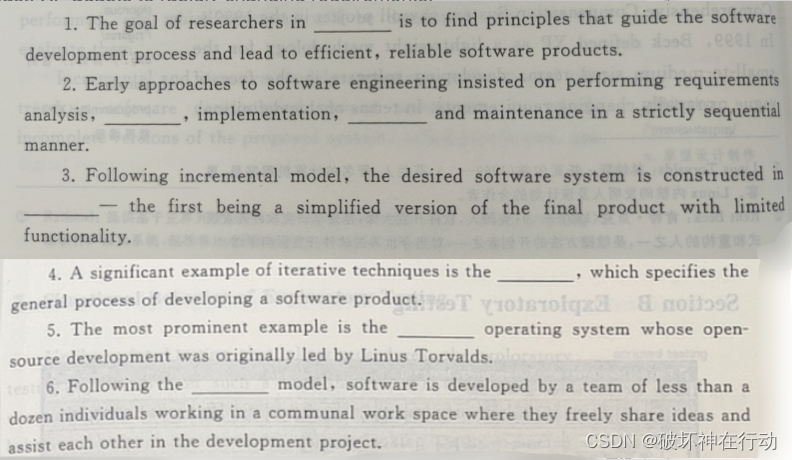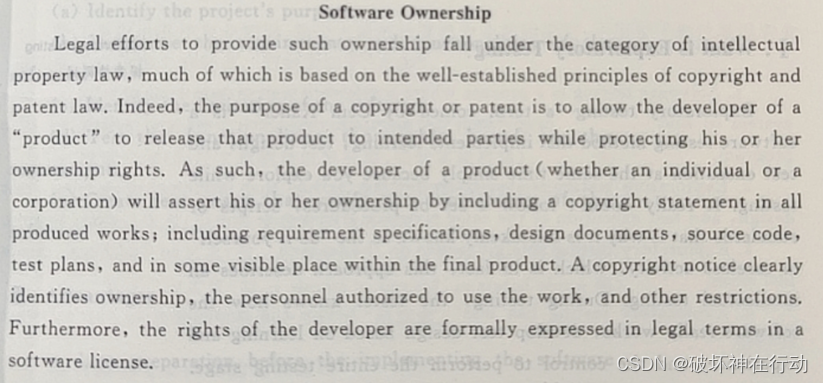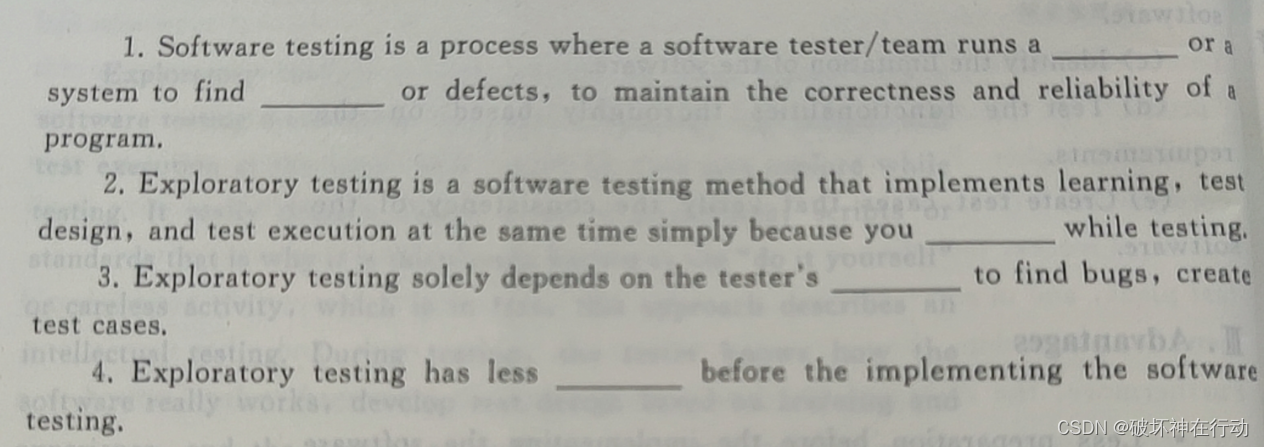Section A Software Engineering Methodologies 软件工程方法论
Software development is an engineering process.
软件开发是一个工程过程。
The goal of researchers in software engineering is to find principles that guide the software development process and lead to efficient, reliable software products.
软件工程研究人员的目标是找到指导软件开发过程并导致高效、可靠软件产品的原则。
1. Waterfall model 瀑布模型
词汇
methodologies n方法论
prohibitively adv过高的
symposium n研讨会
The waterfall model is a sequential design process, used in software development processes, in which progress is seen as flowing steadily downwards through the phases of requirements analysis, design, implementation, testing, and maintenance.
瀑布模型是一种顺序设计过程,用于软件开发过程中,在这一过程中,进展被视为通过需求分析、设计、实现、测试和维护阶段稳步向下流动。
2. Incremental model 增量模型
词汇
contradiction n矛盾
dictate v控制,命令
free-wheeling 单向转动
trial-and-error 试错法,不断摸索
incremental adj.增加的;【数】增量的;增额的
evaluate v评估
In recent years, software engineering techniques have changed to reflect the contradiction between the highly structured environment dictated by the waterfall model and the “free-wheeling”, trial-and-error process that is often vital to creative problem solving. This is illustrated by the emergence of the incremental model for software development.
近年来,软件工程技术已经发生变化,以反映由瀑布模型所决定的高度结构化环境与通常对创造性解决问题至关重要的“自由发挥”、试错过程之间的矛盾。增量模型的出现说明了软件开发的变化。Following this model, the desired software system is constructed in increments—the first being a simplified version of the final product with limited functionality. Once this version has been tested and perhaps evaluated by the future user, more features are added and tested in an incremental manner until the system is complete.
遵循此模型,所需的软件系统以增量方式构建——首先是具有有限功能的最终产品的简化版本。一旦这个版本经过测试,也许已经被未来的用户评估,就会以增量方式增加更多功能并进行测试,直到系统完成。
3. Iterative model 迭代模型
词汇
interative a迭代的
preliminary a初步的
encompass vt围绕
refine vt精炼,提炼
rational unified process(RUP) 统一软件管理
prototyping n原型设计制作
incarnation n化身
open-source development 开源软件的开发
Another model that represents the shift away from strict adherence to the waterfall model is the iterative model, which is similar to, and in fact sometimes equated with, the incremental model, although the two are distinct.
另一种代表从严格遵循瀑布模型转变的模型是迭代模型,它与增量模型相似,实际上有时与增量模型等同,尽管两者是不同的。Whereas the incremental model carries the notion of extending each preliminary version of a product into a larger version, the iterative model encompasses the concept of refining each version.
虽然增量模型带有将每个初步版本的产品扩展到更大版本的概念,但迭代模型包含了精炼每个版本的概念。In reality, the incremental model involves an underlying iterative process, and the iterative model may incrementally add features.
实际上,增量模型涉及一个潜在的迭代过程,迭代模型可能会逐步增加功能。
4. Agile methods 敏捷方法
词汇
pronounced a明显的
responsiveness n敏感性
rigorous a严厉的,严密的
extreme programming 极限编程(XP)
breadth n宽度
Perhaps the most pronounced shift from the waterfall model is represented by the agile methods, each of which proposes early and quick implementation on an incremental basis, responsiveness to changing requirements, and a reduced emphasis on rigorous requirements analysis and design.
也许最明显的从瀑布模型转变是敏捷方法所代表的,每种方法都提倡在增量基础上早期和快速实施,对变化需求的响应能力,以及减少对严格需求分析和设计的强调。One example of an agile method is extreme programming (XP).
敏捷方法的一个例子是极限编程(XP)。In 1999 Beck defined XP as a lightweight methodology for the small-to-medium sized teams developing software in the face of vague or rapidly changing requirements.
1999年,Beck将XP定义为一种轻量级方法,适用于面临模糊或快速变化需求的中小规模团队开发软件。In terms of this definition, XP could be described in four ways.
根据这个定义,XP可以用四种方式描述。Firstly, it is lightweight. In XP you only do what you need to do to create value for the customer.
首先,它是轻量级的。在XP中,你只做你需要做的来为客户创造价值。Secondly, it is a methodology, which based on addressing obstacles in software development. It does not address some specific issues such as financial justification of projects or sales.
其次,它是一种方法论,基于解决软件开发中的障碍。它不解决一些特定问题,如项目的财务理由或销售。Thirdly, it is implemented by a small or medium size, which makes the project team much more flexible. In this kind of team, everyone is elite and has his clear responsibility.
第三,它由小或中等规模的团队实施,这使得项目团队更加灵活。在这样的团队中,每个人都是精英,并且有他清晰的责任。Last but not least, XP adapts to rapidly changing requirements.
最后但同样重要的是,XP适应快速变化的需求。
练习A1(知识点填空)

The goal of researchers in software engineering is to find principles that guide the software development process and lead to efficient, reliable software products.
软件工程 研究人员的目标是找到指导软件开发过程并导致高效、可靠软件产品的原则。Early approaches to software engineering insisted on performing requirements analysis, design, implementation,testing, and maintenance in a strictly sequential manner.
早期的软件工程方法坚持以严格的顺序执行需求分析、设计、实现、测试和维护。Following the incremental model, the desired software system is constructed in increments – the first being a simplified version of the final product, with limited functionality.
按照增量模型,所期望的软件系统是按增量构建的——首先是最终产品的简化版本,具有有限的功能。A significant example of iterative techniques is the rational unified process(RUP), which specifies the general process of developing a software product.
迭代技术的一个显著例子是统一软件管理,它指定了开发软件产品的一般过程。The most prominent example is the Linux operating system whose open-source development was originally led by Linus Torvalds.
最突出的例子是Linux操作系统,其开源开发最初由林纳斯·托瓦尔兹领导。Following the agile model, software is developed by a team of less than a dozen individuals working in a communal work space where they freely share ideas and assist each other in the development project.
按照敏捷模型,软件是由不到十二人的团队在共同的工作空间开发的,他们在那里自由分享想法,并在开发项目中互相协助。
练习A2(词汇翻译)

- Software Engineering: 软件工程,是应用工程原则来开发 and 维护软件的学科。
- Requirements Analysis: 需求分析,是确定系统或软件必须完成什么功能的过程。
- Testing: 测试,是评估软件系统或组件以确定它们是否满足规定要求的过程。
- Maintenance: 维护,指在软件发布后,为了改正错误,提升性能或增加功能而进行的持续工作。
- Software Engineer: 软件工程师,是应用软件工程原理和方法来设计、开发、测试和维护软件系统的人。
- Requirements Specification: 需求规格说明,是详细描述软件需求的文档。
- Waterfall Model: 瀑布模型,是一种经典的软件开发生命周期模型,它将软件开发过程划分为一系列阶段性的活动。
- Incremental Model: 增量模型,是一种软件开发模型,其中软件是逐步构建和发布的。
- Iterative Model: 迭代模型,是一种通过重复一系列开发活动来逐步改进软件产品的方法。
- Rational Unified Process (RUP): 统一软件开发过程(RUP),是一种以迭代和增量的方式进行软件开发的流程。
- Software Life Cycle: 软件生命周期,指软件从概念、设计、实现、测试、部署到维护的整个过程。
- Agile Methods: 敏捷方法,是一组软件开发方法论,强调适应性和快速响应变化。
- Extreme Programming (XP): 极限编程(XP),是一种敏捷软件开发方法,旨在提高软件质量并促进快速响应变化。
翻译

Software Ownership
软件所有权
Legal efforts to provide such ownership fall under the category of intellectual property law, much of which is based on the well-established principles of copyright and patent law.
提供此类所有权的法律效应属于知识产权法的范畴,其中很多都是基于已经确立的版权法和专利法原则。Indeed, the purpose of a copyright or patent is to allow the developer of a “product” to release that product to intended parties while protecting his or her ownership rights.
的确,版权或专利的目的是允许“产品”的开发者在向预定的各方发布产品的同时,保护他或她的所有权。As such, the developer of a product (whether an individual or a corporation) will assert his or her ownership by including a copyright statement in all produced works; including requirement specifications, design documents, source code, test plans, and in some visible place within the final product.
因此,产品的开发者(无论是个人还是公司)将通过在所有产生的作品中包含版权声明来主张他或她的所有权;包括需求规格说明、设计文档、源代码、测试计划,以及最终产品中的一些可见位置。A copyright notice clearly identifies ownership, the personnel authorized to use the work, and other restrictions.
版权声明清楚地识别了所有权、被授权使用作品的人员以及其他限制。Furthermore, the rights of the developer are formally expressed in legal terms in a software license.
此外,开发者的权利在软件许可证中以法律术语正式表达。
Section B Exploratory Testing 探索性测试
词汇
bug n错误,漏洞
Test case 测试用例
scripted testing 脚本测试
trail and error 反复试验
tactic n战术
练习B1(知识点填空)

Software testing is a process where a software tester/team runs a program or a system to find bugs or defects, to maintain the correctness and reliability of the program.
软件测试是一个过程,软件测试人员/团队运行程序或系统以发现错误或缺陷,以保持程序的正确性和可靠性。Exploratory testing is a software testing method that implements learning, test design, and test execution at the same time simply because you explore while testing.
探索性测试是一种软件测试方法,它可以同时实现学习、测试设计和测试执行,因为你可以在测试时进行探索。Exploratory testing solely depends on the tester's skill to find bugs and create test cases.
探索性测试完全取决于测试人员发现 bug 和创建测试用例的技能。Exploratory testing has less preparation on formal documentation before the implementing the software testing.
在实施软件测试前,探索性测试对正式文件的准备较少。
练习B2(词汇翻译)

- software testing - 软件测试
- exploratory testing - 探索性测试
- scripted testing - 脚本化测试
- trial and error - 试错法
- bug - 缺陷/漏洞
- test case - 测试用例





)







如何在Spring中使用缓存)


本地一键整合包下载)


